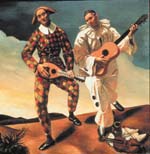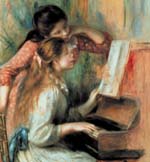One-stop exhibition
Viewers gain chance to see famous collection, ‘From
Renoir to Picasso’
By Reagan Duplisea
skiff staff
Paintings of clowns from the Kimbell Art Museum’s latest exhibition grace billboards, benches and buses across the Dallas/Fort Worth area, but the fact that the museum is the only U.S. venue where the collection will be exhibited is nothing to joke about.
“From Renoir to Picasso: Masterpieces from the Musée de l’Orangerie” is making its way around the world as its Paris home is undergoing renovation.
The collection features 81 paintings from the collection of Paul Guillaume, a Parisian art dealer of the early 20th century. It’s thanks to Guillaume’s excellent taste and willingness to see the talent behind innovation that artists like Henri Matisse are household names today.
The exhibition is arranged brilliantly in that it displays many of the same genres by different artists next to one other. Pierre-Auguste Renoir’s and Paul Cézanne’s portraits of their respective 8-year-old sons hang side by side, yet even the inexperienced eye can detect the vast stylistic differences between the two artists. Although painted just 30 years apart, the artists’ depictions of similar subjects drastically differ.
Renoir’s “Claude Renoir in Clown Costume” is a larger-than-life, full-length portrait, glorifying the happy, healthy child in soft, warm hues. Yet in Cézanne’s “Portrait of the Artist’s Son,” the boy is painted from the chest up and has a sickly, green tinge to his woeful face.
 |
|
Special to the Skiff
(Left) “Harlequin and Pierrot” (1924), by André Derain, is on display at the Kimbell. |
Museum-goers can also compare artist interpretations in several depictions of Guillaume, the originator of this vast collection. They vary from Amedeo Modigliani’s Charlie Chaplinesque painting in harsh reds and browns to André Derain’s rendering that is much more naturalistic, in which the figure seems to appear through a fog.
Just as intriguing is comparing the works of the same artist through different stages in his career. Within a few feet, visitors can see Pablo Picasso’s transition from Impressionistic-like portraits to abstract views where facial features are scattered like unsolved puzzle pieces.
Many people feel that Impressionist paintings, such as Claude Monet’s coast scene “Argenteuil,” should be observed from far away so the image appears clear. But take this opportunity to take a very close look at the artists’ handiwork. By examining the short, thick brushstrokes of varying color, an appreciation can be gained for the skill displayed on each canvas.
The collection features many unique works that aren’t to be found just anywhere.
Canvases are usually the standard broad rectangle, so it’s the long, thin form of Cézanne’s “Boat and Bathers” that catches the eye. Painted with a palette of brilliant blues, the work was originally placed above the doorway of its patron.
Another work not to be missed is the “Snow-Covered Landscape” by Renoir. The minuscule brushstrokes in white paint catch the light and glisten as if they were indeed ice crystals clinging to leaves and tree trunks.
Many who go to the exhibition may be attracted by the big names of Renoir and Monet, but the other artists exhibited should not be overlooked. Chaim Soutine’s dreamlike works seem to melt off the canvas and are reminiscent of reflections in fun house mirrors. The viewer is almost tempted to bend his or her knees to see if the picture changes.
 |
|
Special to the Skiff
“Young girls at the Piano” (1892), by Pierre-Auguste Renoir, is on exhibit at the Kimbell. |
Also, “The Room Service Waiter” by Modigliani is a comical highlight of the exhibition. The rubber-faced waiter stands with his hands on his hips and seems to ask, “You want me to do what?”
The only thing that could be improved is the price of the exhibition. While the Kimbell opens its doors free of charge to its permanent collection, employees should consider lowering the prices of exhibitions to reach a broader audience. The student rate is $8; however, it’s all but necessary to pay the $4 for the audio guide because few paintings have explanatory panels next to them.
While the $12 is decidedly cheaper than a plane ticket to Paris, the Kimbell employees should recognize the varying economic levels of visitors if they seek to educate and provide their public with an exposure to culture.
Reagan Duplisea
elsinore_skye@hotmail.com
Newest Left Behind book makes mark on readers
‘The Mark’ proves to be exhilarating tale of resurrection, oppression in popular apocalyptic series

By Christina Hager
skiff staff
Authors Tim LaHaye and Jerry B. Jenkins have certainly hit the mark with their newest book in their successful Left Behind series.
They have receivedacclaim by critics and scholars alike for this series of conceptualized accounts of the end-times Rapture and Tribulation found in the Bible.
Released only two weeks ago, the latest book, “The Mark” is the eighth book in this apocalyptic series based on the prophecies from the book of Revelation.
At the beginning of this section of the tale, Nicolae Carpathia, who is potentate of the global community and deemed the Antichrist by Christians, returns from the dead. After his “resurrection,” the non-Christians begin to worship him as a god, bowing before him. Carpathia, wanting to establish even more power for himself, institutes a worldwide order, which says that every human being shall receive a mark, which the Christians label the “mark of the beast.”
Without this special symbol and computer chip, you can’t buy, sell or trade in the global market. As hundreds volunteer to become the first to receive the mark, believers are forced to make hasty escapes to their underground network. However, those who are not able to escape must die if they refuse the mark.
Written with the same intensity and spiritual presence as the first seven books, “The Mark” is a fast-paced and complicated tale. Although not recommended for those who have yet to read the first books in the series, the story is a powerful one that leaves the audience questioning their own faith and wondering what the next chapter holds.
Christina Hager
ctinasing2000@aol.com